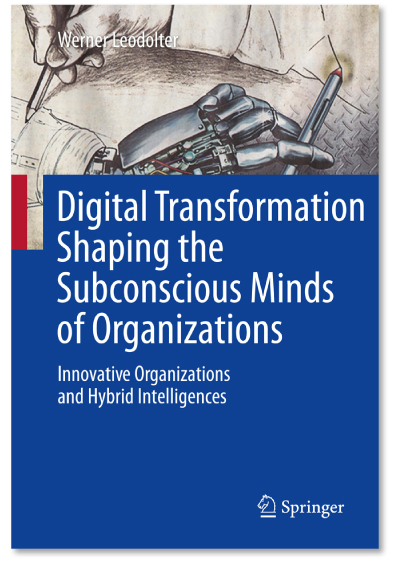HealthManagement, Volume 17 - Issue 5, 2017
Shaping the minds of organisations
Professor Werner Leodolter speaks to HealthManagement.org about managing the technology-induced change in decision making in organisations detailed in his new book.
The digital transformation is changing the subconscious minds of organisations. Humans increasingly collaborate with robots, artificial intelligence (AI) and machine learning thus forming hybrid intelligencies, which have to be integrated in organisations.
In your book, why do you refer to the ‘subconscious mind’ of an organisation? Isn´t the subconscious something specifically human?
It is, in fact, ‘human specific’. Let me give you an example. When I first learned to drive, I was fully and consciously concentrated on driving - on every gear change, use of the indicator, etc. After a relatively short period of time and frequent driving it started to become automatic and I could turn my attention to other things like talking with my passenger or listening to the radio. My subconscious mind partly took over. Today we have all sorts of options and assistance available in our cars: automatic drive, car phone, voice recognition, navigation system, parking sensors and proximity warning for instance.
What is happening in organisations?
In organisations more and more decisions are being assisted with decision support systems or are even automated. Collaboration between man and machine is increasing. Hybrid intelligences are emerging. It’s like when you drive a car as a human. You drive with less effort having delegated a lot of action patterns to your subconscious mind and using the technology of assistive systems.
But when driving in a highly-assisted mode there is one crucial question: Will I also be able to react properly in specific maybe dangerous situations? Will I even recognise them?
There is the same question in an organisation: Will I recognise critical developments early enough? How will my organisation deal with uncertainty and unforseeable developments when it is used to automatic decision-taking by algorithms which are good in routine situations?
So it is all about how decisions are taken. Mental and algorithmic models as parts of the subconscious mind of your organisation significantly influence and drive the decisions taken.
What is it that changes the way decisions are taken in organisations?
Technology changes the cognitive process of individuals as well as of organisations. Cognitive computing already directly adresses cognitve processes which were a privilege of humans until now.
Which elements of the cognitive process a rechanged?
Perception is changed by virtual reality, augmented reality, mixed reality, social media, ubiquitous sensors and drones.
Analysis and interpretation are changed by pattern recognition, realtime analysis and several forms of AI.
Decision support and automated decisions are enabled by AI too.
What is an example for changed perception and decision making of organisations?
Here is an example from healthcare:
Perception: Email-visit, telemonitoring weight, glucose level, blood pressure, pacemaker etc. change the perception and the view of a hospital as organisation towards the patient.
Decision: The decision can be suggested that everything is ok or there is action required but there is no need to come to the hospital. For example, you just have to change the dose of medication or you immediately send emergency transport to b ring a patient to the hospital.
Here is another example from industry:
Perception: Sensors on the gears and motors of a rolling mill are sensing vibrations, noise, temperature etc. following a certain load situation depending on the parameters of the dimensions and steel qualities that are being rolled. The organisation and its systems thus perceive differently and when the patterns change this might indicate upcoming trouble.
Better decision: The systems tell you, when you have to change bearings for maintenance reasons etc.
So what is the subconscious mind of organisations?
The subconscious mind of an organisation serves as metaphor for the socio-technical construct of an organisation. It consists of:
- Technical infrastructure (which enables t he organisation of
the subconscious and conscious behaviour driven by digital transformation)
- Structures and processes of an organisation (formal and
informal rules)
- Values, attitudes and strategies.
It provides a framework to promote and leverage digital transformation in healthcare, in industry and nearly all other kinds of businesses.
What is the benefit of applying this metaphor?
Routinely, in business and private life, we always have to (at least should) be aware of how humans think with all the pitfalls but also all the wonderful human abilities such as intuition, creativity, innovation, empathy and common sense. Simply apply this to your organisation consisting of humans and their behaviour. But the organisational behaviour is also affected by machines, infrastructure, algorithms and AI for instance.
This helps you and encourages you to detect bias in data used by algorithms - especially as data is always past tense. It helps you to look at it more critically. It helps you as a manager to get a clearer view when you have to intervene in automatic decision making in subordinated Organisational Units (OU´s) or in hybrid intelligences or in automated decision making by algorithms.

It helps you in how to keep governance - how to stay in the driver’s seat as a manager or in general as a human being while using assistance provided by technology in a sensible way.
How can the subconscious mind of an organisation be shaped?
There are many ways to do this. Provide elearning, microlearning and simulation tools so they keep you in shape to assess situations on your own with all your human repertoire. Drill your staff in systems thinking and consistent argumentation. Ensure responsibility and accountability from the individual employee.
There is a great deal to be done for developing a culture concerning responsibility when you establish or shape collaboration between humans and between humans and machines.
I am convinced that only flat organisations, or organsations with minimal levels of middle management, will emerge as successful on the journey through the digital transformation. There are some more guiding principles on this provided and exemplified in my book.
Where will the
digital transformation lead us?
We simply do not know where digital transformation will lead us. Uncertainty is not vanishing from earth because we have big data and prediction algorithms.
Look at political developments stumbling from crisis to crisis. I know a wonderful picture with a sad-looking dog, saying: “When I knew all the answers they changed all the questions“. That is where we are. Technologies in many fields are in the dynamic phase of their exponential developments – and all at once it seems.
So we need new models of thinking and scrutinising decision proposals. We have to organise ourselves anew to be able to cope with the challenges posed by the exponential developments in AI etc. The metaphor of the subconscious mind of organisations will help.
What will the role of humans be in hybrid intelligences?
In the closer collaboration between man and machines, we see with all kinds of assistive systems, chatbots and decision support systems, Robots moving among people in warehouses and in hospital wards. From this ever closer collaboration, hybrid intelligences will emerge. This will challenge us to stay in the driver´s seat in important issues. Machine learning detects patterns of our decisions and actions and will incorporate this in its decision proposals and thus will increase the pressure on us as humans.
Where will we want to rely on assistive AI ? Where will we keep the freedom to stay on our own? What will be the role of humans in future?
The basic principle should be: People do not serve structures but organisations, technology and structures serve people.
What will the role of humans be in future in general?
I am convinced that repetitive tasks will be taken over by AI. Core human abilities like imagination, ingenuity, creativity, adaptability, responsibility, common sense, ethical capacity, to feel and communicate empathy and trust, the ability to dream and love will not be emulated in the next two decades. Let us be positive: AI will make human Intelligence more valuable than ever.
How can I get started in my organisation with shaping its subconscious mind?
First: Apply this metaphor of the subconscious as model of thinking and establish cybernetic and systems thinking by challenging your employees to argue their proposals in this way. Then, with this in mind, analyse perception and decision making now and in future, envisioning the upcoming AI and decision tools. Additionally, analyse how your organisation is embedded in business and in society and what is going to change. Finally: look for a trigger to get started like an adverse event or an obvious need to change your business model.
In my book "Digital Transformation Shaping t he Subconscious Minds of Organizations - Innovative Organizations and Hybrid intelligences" you find some helpful guiding principles supported by lucid stories. Let us make sure that - metaphorically speaking - we "stay in the driver’s seat" and we have established the governance to at least set the direction and to intervene when partly autonomous driving takes us the wrong way.
Key Points
- Digital transformation is changing the subconscious minds of
organisations
- Collaboration between man and machine is increasingly
forming hybrid intelligences
- Technology is changing the cognitive process of individuals
and organisations
- Horizontal organisations will emerge as successful in
digital transformation
- We don’t know where digital transformation will lead us
- To shape the subconscious mind of an organisation, provide
e-learning, microlearning and simulation tools, drill staff in systems thinking
and ensure responsibility from individuals.
For information on "Digital Transformation Shaping the Subconscious Minds of Organizations – Innovative Organizations and Hybrid Intelligences" go to: springer.com/in/book/9783319536170
















